 Home
Home Up
Up Search
Search Mail
Mail
NEW
MegaSound: Sound in Irish neolithic buildings
Acoustic measurements were done at several locations (see for my
presentation at First pan-American/Iberian
meeting on acoustics, December 4th, 2002):
Some reference measurements:
Tools
Tools used: ETF
computer program, sound card (in Dell Optiplex GX1), bass guitar
amplifier
(Ampeg, SVT-15T,
speaker
is some 40 cm in diameter) or Logitech
Z-540 sub woofer and analogue SPL meter (RadioShack 33-2050).
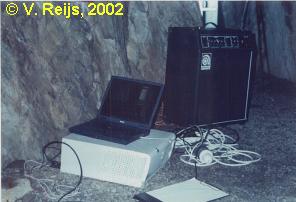 The SPL meter (microphone) has been positioned at two different levels:
Low (circa 0.4 m above ground level) or High (circa 1.1 m above ground
level). The center of the speaker is around 0.3 m above ground level
and
some 0.3 m from wall.
The SPL meter (microphone) has been positioned at two different levels:
Low (circa 0.4 m above ground level) or High (circa 1.1 m above ground
level). The center of the speaker is around 0.3 m above ground level
and
some 0.3 m from wall.
Some tips
- When using the RadioShack SPL meter, put it on WEIGHTING C
for
full
frequency response.
- Use ETF in Full Range measurements.
- Give the equipment time to adjust to different temperature and
damp
environment
(to reduce condensation).
- Check noise level with speaker muted. Check if there is
constantly
50/60
or 100/120 Hz or other frequencies present (do this with the 3D low
frequency
waterfall graph). Try to eliminate these grid-power or other related
spurious
frequencies.
- Check noise level with microphone not connected, but having the
cable
which
would go to microphone in the computer.
- Measure the frequency response of the
equipment,
by putting the microphone just in front (maximum some 20 cm) of speaker
(in free air or in a room with as low as possible reflections) and then
check the low frequency response of this system.
- One can type in this frequency response of the measurement system
into
a mic.cal file, and thus compensating the room measurements.
After
this is done, don't change any frequency control (like
weighting
or equalizing) on microphone or amplifier/speaker, otherwise repeat the
measurement of the frequency response of the
equipment.
This procedure has not been used in the below measurements for
Fourknocks
I, Dowth South, bathroom and bedroom. So the power level at the
peaks
is a result of the room resonance and the output of the speaker
and
the output of SPL meter at that frequency. So in these cases, one can
only
say that at a peak a resonance frequency exists, but not if it
is
the strongest! - Put speaker as close as possible to a corner, just
to excite as
many resonance
frequencies as possible.
Frequency response of equipment
The frequency response of the equipment used (Ampeg speaker plus
microphone
and
not the room) is approximately:
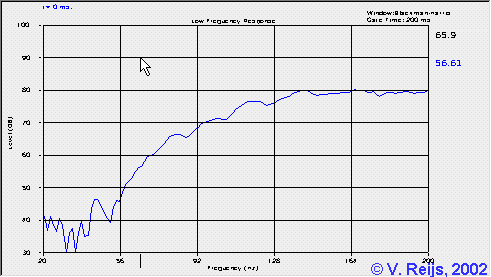
Frequency response of Ampeg equipment (microphone some 20 cm from
speaker)
The Logitech Z-540 performed much better (used in bathroom and
iron-age
dwelling:
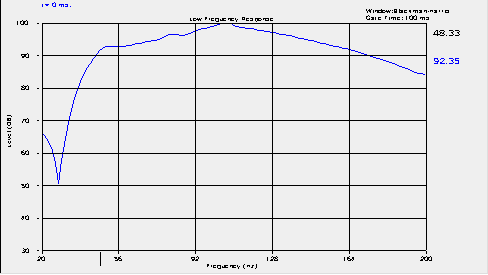
Frequency response of Logitech Z-540 equipment (microphone some
5 cm from speaker)
Fourknocks I
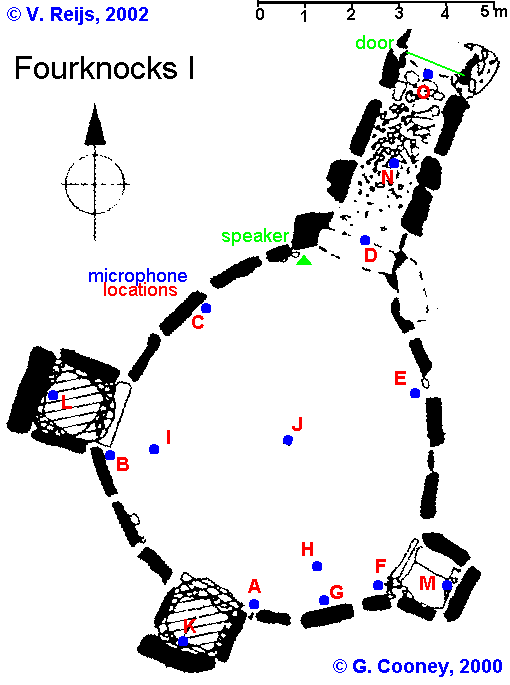 The height of the modern ceiling at the top is around 2.6 m and at the
edges around 1.6 m (a concrete dome). It is expected that the original
ceiling could have been a framework of rafters [Cooney,
2000, page 104]
The height of the modern ceiling at the top is around 2.6 m and at the
edges around 1.6 m (a concrete dome). It is expected that the original
ceiling could have been a framework of rafters [Cooney,
2000, page 104]
The orthostats are boulders of rocks, spaces between orthostats is
filled with packing stones and the floor is trampled sand.
30 measurements were done (most at Low level and some with door
closed).
The outside temperature was around 7 °C.
Speaker direction perpendicular to wall.
Measured with Ampeg Speaker
Crossover frequency F2: ~60 Hz
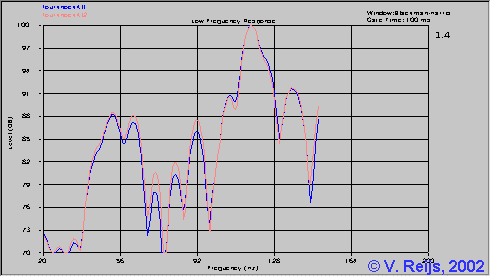
Frequency response (between 20 and 200 Hz) at point K (Low level
and door open)
Dowth South
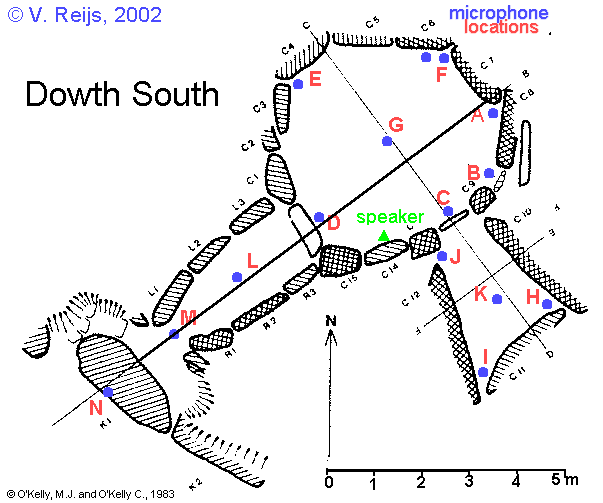 The average height of the modern ceiling is 1.9 m (almost a flat
concrete
ceiling). It is expected that the original ceiling would have been
corbelled
[O'Kelly, 1983, page 156]
The average height of the modern ceiling is 1.9 m (almost a flat
concrete
ceiling). It is expected that the original ceiling would have been
corbelled
[O'Kelly, 1983, page 156]
The orthostats are boulders of rocks, spaces between orthostats is
filled with packing stones and the floor is trampled sand.
40 measurements were done (most at Low level).
The outside temperature was around 10 °C.
Speaker direction perpendicular to wall.
Measured with Ampeg Speaker
Crossover frequency F2: ~100 Hz
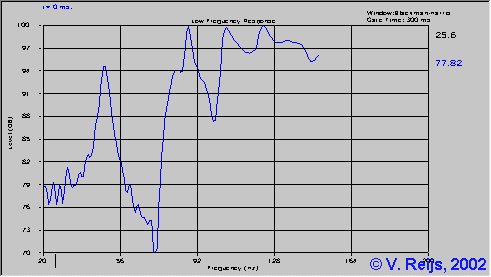
Average of frequency response (between 20 and 200 Hz) at Low level
After the white noise of ETF, a clear tone was heard inside the
chamber.
It was at least audible for some 0.25 sec and its frequency somewhere
around
600 Hz (although I have no musical ears, it could be off with a few 100
Hz).
Bathroom at home
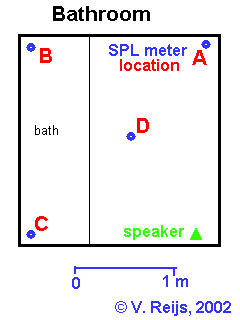 The height is 2.45 m (plastered ceiling, brick walls).
The height is 2.45 m (plastered ceiling, brick walls).
Temperature around 15 °C.
Speaker direction towards point B.
Measured with Ampeg Speaker
Crossover frequency F2: ~415 Hz
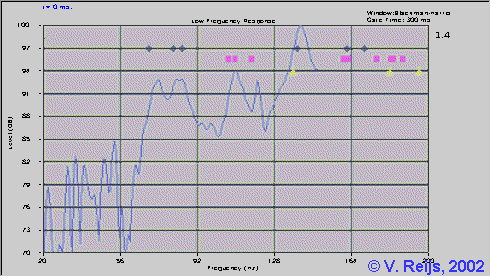
Average of frequency response (between 20 and 200 Hz) at High level
The blue lozenges, purple squares and yellow triangles are the
theoretical
resonance frequencies resp. axial, tangential and oblique modes.
Bedroom at home
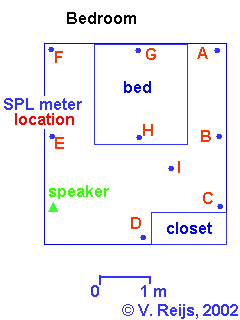 The height is 2.45 m (plastered ceiling, brick walls). Length: 4.04 m
and
width 3.76 m.
The height is 2.45 m (plastered ceiling, brick walls). Length: 4.04 m
and
width 3.76 m.
Temperature around 15 °C.
Speaker direction towards point C.
Measured with Ampeg Speaker
Crossover frequency F2: ~170 Hz
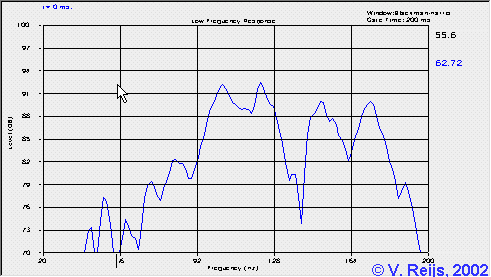
Frequency response (between 20 - 200 Hz) at point A and High level
Considerations
- Human sound production:
- The human voice pitch
(f0: the fundamental frequency of the human vocal cords) is
at present days for normal male speaking voice between 110-130 Hz and
for
normal female speaking voice between 200-230 Hz. Children is around 300
Hz. Singing can produce different pitches of course (higher and lower
of
some ??? Hz).
Remark: Pitch is sometimes also used just as a synonym to frequency
of a sound and sometimes it is related to the perceived
frequency of a sound (expressed in [mel] instead of [Hz]). But on
this
web site it is used only for the fundamental frequency of the vocal
cords
f0. - In former times people were smaller,
so
it is expected
that the pitch would have been higher. Now
a days British males are around 174 cm, so compared to European
neolithic
times (164.2 cm) the pitch could have been some 6 % higher (assuming a
linear behavior between pitch and height). So this gives the following
pitch frequency ranges:
| |
Present times
Avg. speaking pitch
(fo) [Hz]
|
Neolithic times
Avg. speaking pitch
(fo) [Hz]
|
| Male |
~120
|
~127
|
| Female |
~215
|
~228
|
| Child |
~300
|
~320
|
- Equipment/methodology:
- Looking at the frequency response of my
measurement
equipment used at Fourknocks I and Dowth South; it has some 32 dB
at
56 Hz attenuation. That is quiet a lot. According to a
web source, the SPL meter has some 8 dB at 20 Hz (or around 2
dB at 50 Hz) attenuation. So it looks the speaker/amplifier is not
really
a sub-woofer system;-).
- The above mentioned frequency response of my Ampeg measurement
equipment
also causes the peaking around the 100 Hz range. If one would
compensate
for the measurement equipment, the peaks of the resonance frequencies
would
be quite flat in the 20 - 200 Hz range.
- For measurements in bathroom and iron-age dwelling I used
a
Logitech
Z-540 subwoofer system (35 - 200 Hz), this performed much better than
the
Ampeg system down to 35 Hz (at -35 dB).
- A good source for making a sub woofer can be found
here.
- The equipment that Devereux and Jahn ([2002], pers. comm.)
used, had a
frequency range between 20 - 200 Hz (speaker) and 32-10,000 Hz
(microphone).
- The peaks found by Devereux and Jahn ([2002], pers. comm.) were
done by
listening to the sound. Because the equal-loudness contours of the
human
ear are quite steep at low frequencies (difference of some 30 dB), real
peaks below 100 Hz are perhaps not heard due to this.
- The rooms:
- Looking at the above measurements in rooms, the frequency
responses of
the measured (badly rebuild) megalithic chamber are not very
different
from modern house rooms.
- A theoretical sensitivity study using
Monte Carlo analysis has
been
done
to determine the chance of an arbitrary room having no axial
modes
of certain values and the chance of modal
coloration
according to Gilford. This study revealed the following (using
rooms
with x, y and z sides ranging randomly between 1.5 and 6 [m] and using
some 5500 runs with Monte Carlo analysis):
|
Pitch range
|
Chance of no axial
modes
in pitch range
|
Chance of coloration
according to Gilford
|
Now
(105-130 Hz) |
10%
|
31%
|
Neolithic
(115-140 Hz) |
10%
|
31%
|
- A comparison with an iron-age dwelling (with thatched walls and
roof)
is
done. Results will be published soon.
- Some benchmarks:
- When the crossover frequency F2
is high (like in the bathroom), the theoretical normal modes can be
easily
seen back in the frequency response graph. For
the
other rooms an easy one to one mapping of the normal modes and the
peaks
in the graphs is not that apparent.
- The crossover frequency for
Dowth
and
Fourknocks are resp. around: 100 and 60 Hz. Above these frequencies,
normal
modes will not be able to explain the measured freq. response, but also
the sound ray theory comes into play (angle of incidence equals angle
of
reflection).
- The one used for the above Monte Carlo analysis is on coloration (quote
from Everest [2001],
page 351):
"Colorations caused by acoustic anomalies of ... rooms are
devastating
to speech quality. Gilford states that axial modes spaced approximately
20 Hz or more, or a pair of modes coincident or very close, are
frequent
sources of colorations. He also states that colorations are likely to
be
audible when an axial mode coincides with a fundamental (f0)
or first format (F1) of at least one vowel sound of speech,
and are in the region of high-speech energy. Speech colorations below
80
Hz are rare, because there is so little energy in speech in that part
of
the spectrum. There are essentially no speech colorations above 300 Hz
for either male or female voices. Modal colorations are more noticeable
in speech than in music."
- Some considerations about the present results:
- It is quite difficult from the above measurements to determine
a
possible
preference (coloration) for male or female usage of the buildings,
because
only measurements up to 200 Hz have done.
- All the above measured megalithic rooms have rebuild ceilings.
It is
recommended
to do measurements also in as intact as possible chambers like; Cairn L
(Loughcrew), Maeshowe (an ideal acoustical setup, which such smooth
walls) and Newgrange. This also will provide a better
comparison
with
already measured megalithic rooms by Devereux and Jahn [2002].
- Newgrange
seems to be also
an ideal Helmholtz resonator, but is
it? I have a few queries on this. A Helmholtz resonator must have a
defined chamber and a 'pipe'.
Where do you see the two coming together:
- Is it around C1-C21?
If it is C1-C21, the area of the pipe is not much smaller than the
chamber area, in which case the Helmholtz resonance formula is not
really valid...
- Or could it be around L17-R15 (O'Kelly [1982], page 99)?
L17-R15 is where the ceiling of the passage is low (again). I think
this is the most likely situation for the original building.
- Or
is it L11-R10?
There could be a problem with the lowest
ceiling above the L17-L19/R15-R17 which could have an acoustical
coupling with the 'pipe (due to possible holes in this roof). In the
case, the
roof is slowly rising from L11-R10 towards the chamber.
- Where does the passage start (after R3-L3)? This because
there is a relative large gap due to the roofbox end.
- Furthermore there is K1 nearby the entrance (only 164 cm away
and 64 cm high). Would that not change the behavior at such low
frequencies?
- So it is not really an easy case (for the
'original' situation). In the 'present' case it could even be more
difficult due to the many holes in the passage and the modern
enclosure. But one could perhaps measure it with a sound source inside
the chamber (and frequency between 0.5
to say 10 Hz).
- A more detailed modeling is being
investigated.
- My idea is that megalithic buildings were rare in neolithic
times and
because
most dwellings were of wood/thatch/open spaced, the totally different
acoustic
experience could make the megalithic buildings extra special. Acoustic
measurements in such an replica of an iron-age dwelling have just been
done, the results will be published soon.
- I am not convinced yet that the megalithic chambers were
specially
build
to color the human voice (around 95-120 Hz according to Devereux [2002],
page 88). I think though that the special acoustic properties for these
rooms (compared to the normal dwellings) could have been used in
ceremonies.
Acknowledgments
I would like to thank the following people for their help and feedback:
Raymond Balfe, John Coltman, Paul Devereux, Ray Dessy, Paul Kelly, David Lubman,
Cees de Laat,
Doug
Plumb, Franz Thomanek, Clare Tuffy and Joe Wolfe. Any remaining errors
are my
responsibility
of course!!! If you want to provide feedback, let me
know.
Disclaimer and Copyright
 Home
Home Up
Up Search
Search Mail
Mail
Major content related changes: Feb. 9, 2002











